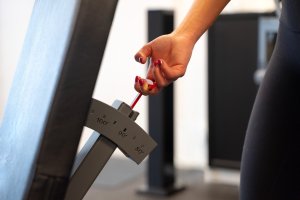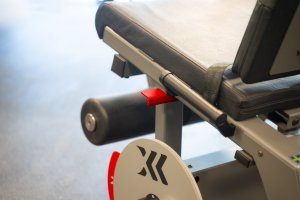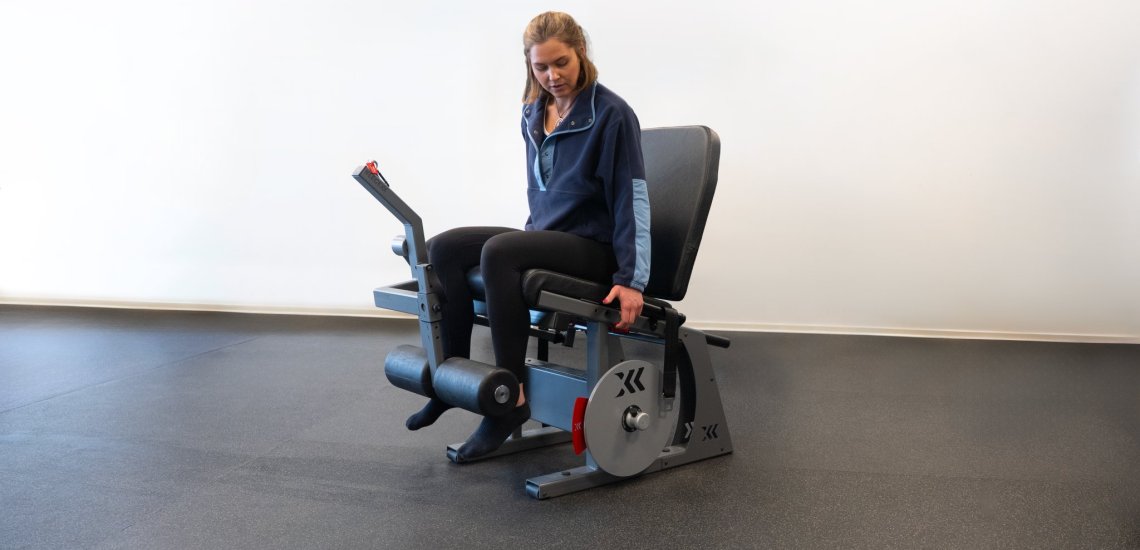In the quest for maximal muscle growth, exercise selection is paramount. However, how an exercise is performed can be just as crucial. A growing body of scientific literature suggests that training muscles at long muscle lengths can be a powerful stimulus for hypertrophy, as discussed below by our Head of Sales & Marketing, Sai Iyer.
At Exxentric, we are dedicated to creating equipment that leverages these scientific principles. That’s why we’ve just upgraded our LegExx and LegFlexx devices to facilitate training at longer muscle lengths, a key factor for unlocking superior muscle growth.
The core of this upgrade is a newly engineered, adjustable backrest. This feature allows for precise angle adjustments between the seat and backrest from 80 to 110 degrees in 5-degree increments, giving you unprecedented control over the muscle lengths you can achieve during training.

The Science: Why Training Under Stretch Matters
The principle of mechanical tension is a cornerstone of muscle hypertrophy. A significant and growing body of research now indicates that applying this tension while a muscle is in a lengthened (stretched) position can dramatically amplify the hypertrophic response. This isn’t just a theory; it’s a phenomenon observed across numerous muscle groups in controlled clinical trials.
The effectiveness of this principle for the lower body is compelling. For the quadriceps, a 2024 study by Larsen et al. found that leg extensions performed at long muscle lengths resulted in greater muscle hypertrophy compared to training at short lengths. For the opposing muscle group, a 2021 study by Maeo et al. demonstrated that training the hamstrings in a lengthened position (like in a seated leg curl) led to greater muscle growth than training at shorter lengths. In fact, it was because of this growing body of evidence that the LegFlexx was originally constructed as a seated leg curl. Now it has been further optimized with an adjustable backrest to increase stretch on the hamstrings even more.
This principle isn’t limited to the quadriceps and hamstrings; it has been shown to be a widespread phenomenon. For example, a study by Maeo et al. (2023) showed that overhead triceps extensions, which place the long head of the triceps in a greater stretch, produced significantly more growth (1.5-fold) than traditional pushdowns. This holds true for other muscle groups as well, with studies on the biceps (Sato et al., 2021) and calves (Kassiano et al., 2023) showing similar benefits when training at longer muscle lengths.
The benefits of training in the stretched position are so profound that even partial ranges of motion can produce exceptional results. A 2022 study by Pedrosa et al. investigated this using the leg extension and found that training with partial repetitions in the lengthened position produced not only greater quadriceps hypertrophy than partials in the shortened position, but also resulted in similar muscle growth to training with a full range of motion.
This enhanced growth is thought to be due to greater stretch-mediated tension and a more robust anabolic signaling response when a muscle is loaded while elongated. By implementing this methodology, you are leveraging a powerful, evidence-based stimulus for muscular adaptation.
How the SingleExx Devices Leverage This Principle:
- LegExx for Quadriceps: The quadriceps muscles, particularly the rectus femoris, cross the hip joint. By reclining the backrest of the LegExx towards its maximum 110-degree angle, you increase hip extension. This places the quadriceps into a lengthened state, allowing you to load the muscle fibers in this highly effective range for hypertrophy.
- LegFlexx for Hamstrings: The hamstrings cross both the hip and knee joints. To place them under significant stretch, you need to flex at the hip. By setting the LegFlexx backrest to a more upright angle, like 80 degrees, you create this hip flexion. This, combined with a straight lower back and spine, puts the hamstrings into a lengthened position before you even initiate the curl, maximizing the growth stimulus throughout the exercise.
Maximum Tension for Performance, Versatility for Rehab
The granular 5-degree adjustments of the backrest are not just for those chasing hypertrophy. This precision is invaluable for a wide range of applications:
- Maximizing Hypertrophy: Athletes can fine-tune the backrest angle to find the position that allows for the greatest possible stretch without causing discomfort, ensuring they are getting the most out of every single repetition.
- Rehabilitation and Injury Prevention: In a clinical or rehabilitation setting, control is key. An instructor can use the adjustable backrest to purposely limit the range of motion and hip flexion/extension based on a patient’s movement ability and recovery status. This ensures that the training remains both safe and effective, providing a progressive path back to full strength.
The LegExx and LegFlexx are, therefore, the perfect tools for the entire spectrum of training needs, from building elite-level muscle and strength to facilitating safe and effective rehabilitation.
Substantial Upgrades for a Superior Training Experience
In addition to the angle-adjustable backrest, the mechanism for sliding the backrest forwards and backwards has been substantially improved to ensure smoother and easier adjustment as well as durability under prolonged use.

By combining the unique benefits of flywheel training with the scientifically-backed principles of training at long muscle lengths, the upgraded LegExx and LegFlexx devices represent the pinnacle of lower body training equipment.
New units are now available for pre-order and will start shipping in September!
References
-
Kassiano, W., Costa, B., Kunevaliki, G., Soares, D., Zacarias, G., Cyrino, E. S., … & Nunes, J. P. (2023). Greater Gastrocnemius Muscle Hypertrophy After Partial Range of Motion Training Performed at Long Muscle Lengths. The Journal of Strength & Conditioning Research, 37(9), 1746-1753.
-
Larsen, S., Gomo, O., & van den Tillaar, R. (2024). The effects of training with short vs. long muscle lengths in the leg-extension on maximal strength and muscle hypertrophy. Journal of Human Kinetics, 91, 215-225.
-
Maeo, S., Wu, Y., Huang, M., Sakurai, H., Kusagawa, Y., Sugiyama, T., Kanehisa, H., & Isaka, T. (2021). Greater hamstrings muscle hypertrophy but similar damage protection after training at long versus short muscle lengths. Medicine and Science in Sports and Exercise, 53(4), 825–837.
-
Maeo, S., Kikuchi, N., Yoshitake, Y., & Kanehisa, H. (2023). Triceps Surae Muscle Hypertrophy Is Greater After Training With Ankle Joint in a More Plantar-Flexed Position. Journal of Strength and Conditioning Research, 37(5), 1018-1024. (Note: This is another relevant Maeo et al. study on the principle; the specific triceps brachii study is “Maeo, S., et al. (2023). Muscle-length-specific hypertrophic effects of elbow-joint-angle-specific resistance training for the triceps brachii.”)
-
Pedrosa, G. F., Lima, F. V., Schoenfeld, B. J., Lacerda, L. T., Simões, M. G., Pereira, M. R., … & Chagas, M. H. (2022). Partial range of motion training elicits favorable improvements in muscular adaptations when carried out at long muscle lengths. European Journal of Sport Science, 22(8), 1250-1260.
-
Sato, S., Yoshida, R., Kiyono, R., Yahata, K., Yasaka, K., Nunes, J. P., Nosaka, K., & Nakamura, M. (2021). Elbow Joint Angles in Elbow Flexor Unilateral Resistance Exercise Training Determine Its Effects on Muscle Strength and Size of Trained and Non-trained Arms. Frontiers in Physiology, 12, 734509.
-
Wolf, M., Androulakis-Korakakis, P., Fisher, J., Schoenfeld, B., & Steele, J. (2023). Partial vs. Full Range of Motion Resistance Training: A Systematic Review and Meta-Analysis. Asian Journal of Sports Medicine, 14(3)


